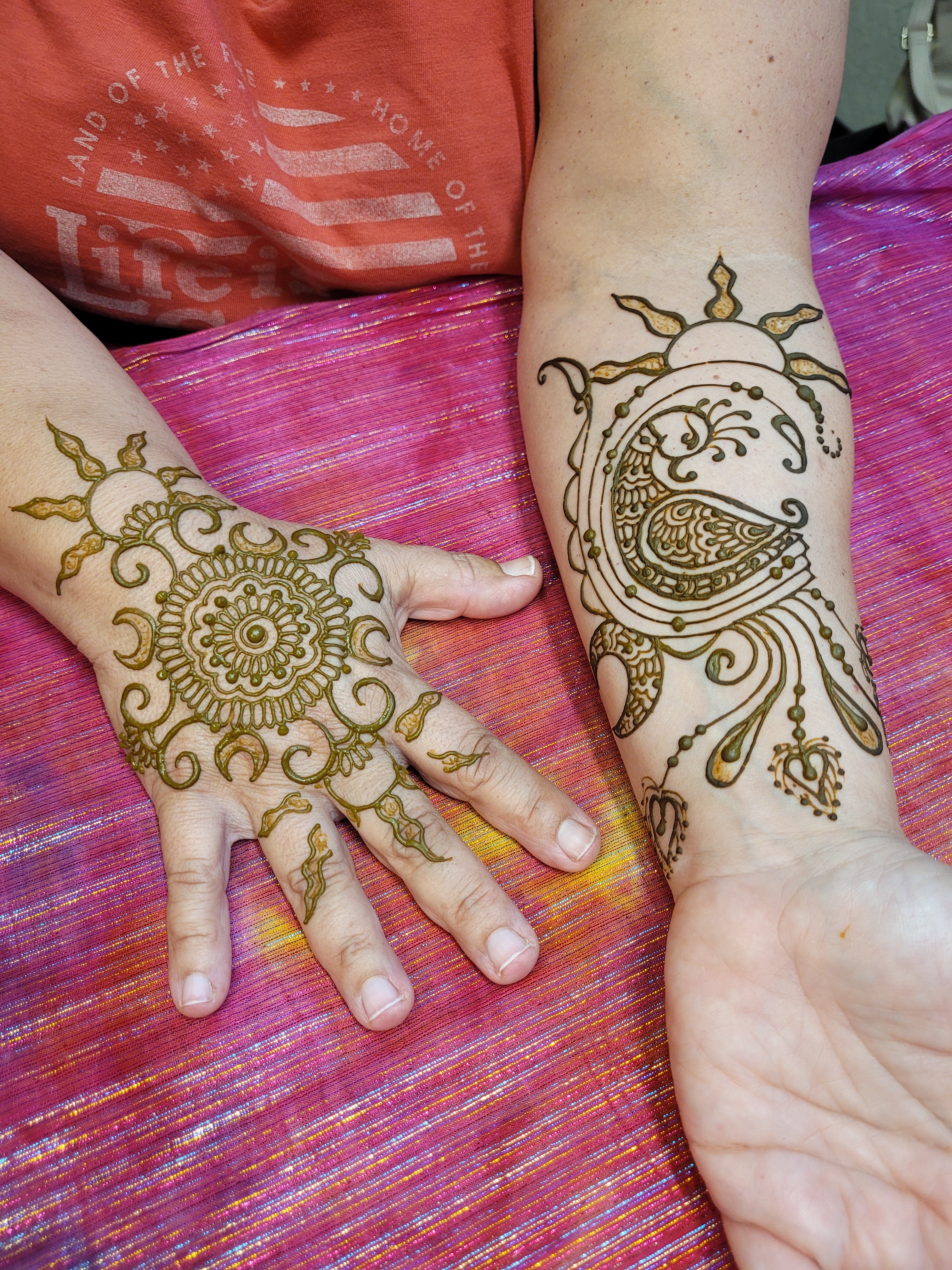Troubleshooting: Reaction to Henna
Reactions to natural henna are rare but possible, with nearly all reactions attributed to the essential oils used in henna rather than the henna itself.
If henna paste is still on the skin and an adverse reaction occurs, remove it immediately using soap and cool water. Treat the reaction as you would any other allergic response and seek medical assistance if necessary.
Always know the ingredients that are used in any henna you apply or is being applied to you.
Normal Reactions to Henna
Some things can be confused with an allergic reaction, but are not harmful.
Itching
As henna dries on the skin, it shrinks and also cools the skin. This can be a little itchy, tickly, or odd-feeling, but is perfectly normal. Essential oils can also cause mild itching. Any extreme itching is an indication to remove the henna immediately.
Slightly Raised Design
Sometimes the henna design itself will be slightly raised on the skin. This is most common on delicate skin areas and is normal. It can be caused by a few different things.
- The addition of lawsone to the keratin in the skin makes the skin cells slightly thicker creating an ever so slightly raised design. This is not harmful.
- Henna often has sugar (or if a sealer is used), the skin may have trapped extra moisture there (like when you wear a Band-Aid) causing the effect of a raised area. This is not harmful.
- Raised portions of a henna design can also happen from peeling off sticky henna. If your henna is really hard to flake off, soak it with oil or coconut oil and then you can gently roll the softened henna off the skin without irritating the skin.
- It can be a slight sensitivity to the essential oils. This is most common on delicate skin areas. Keep an eye on any reactions you see with essential oils in the future, but this is not generally harmful.
The raised design generally settles within a day or so, but can linger longer.
If henna paste is still on the skin and an adverse reaction occurs, remove it immediately using soap and cool water. Treat the reaction as you would any other allergic response and seek medical assistance if necessary. Always have complete ingredients available for your medical professional to review.

Reverse Henna
This picture is of a reverse henna not an adverse reaction to henna. This is what happens when you have a henna stain, and then you get a tan. Henna acts as a natural sun block so when your design fades you get this fun reverse henna design!
Essential Oils and Safety
Essential oils (EOs) are added to henna for various purposes, including enhancing the henna stain, extending paste lifespan, altering texture, and adding fragrance. While generally safe, essential oils can be dangerous and require careful handling.
Only oils specifically sourced for henna should be used, and a safe ratio of henna to oils should be maintained. The maximum recommended ratio is 100g of henna to 30 mL of oil. Use the minimum amount of EOs necessary for desired coloration.
Safety should always take precedence over color enhancement.
Learn more about essential oils here.
Known Disorders
There are two recognized disorders associated with adverse reactions to henna and henna should not be applied to people with these disorders:
-
G6PD Deficiency:
G6PD deficiency, a disorder causing anemia, prohibits individuals—both adults and children—from using henna. Lawsone in henna strongly oxidizes G6PD-deficient blood cells, potentially inducing a hemolytic crisis. People with G6PD deficiency should also avoid certain substances like fava beans, mothballs, some food colorings, and aspirin. They generally know to avoid henna.
-
Hyperbilirubinemia:
Hyperbilirubinemia can trigger severe anemic reactions in infants exposed to henna. The disorder, characterized by excessive bilirubin in the blood, poses greater risks to younger children. Henna application can lead to bilirubin buildup, theoretically this can cause seizures, brain damage, or fatality. While healthy children typically outgrow susceptibility to this condition by age 3, most henna artists refrain from applying henna to children until they are at least 6 years old. Babies who have experienced jaundice should not undergo henna application.
If henna paste is still on the skin and an adverse reaction occurs, remove it immediately using soap and cool water. Treat the reaction as you would any other allergic response and seek medical assistance if necessary. Always have complete ingredients available for your medical professional to review.
More on Our Henna Safety Page

Henna is for Everyone!
We all deserve to feel beautiful and powerful!
